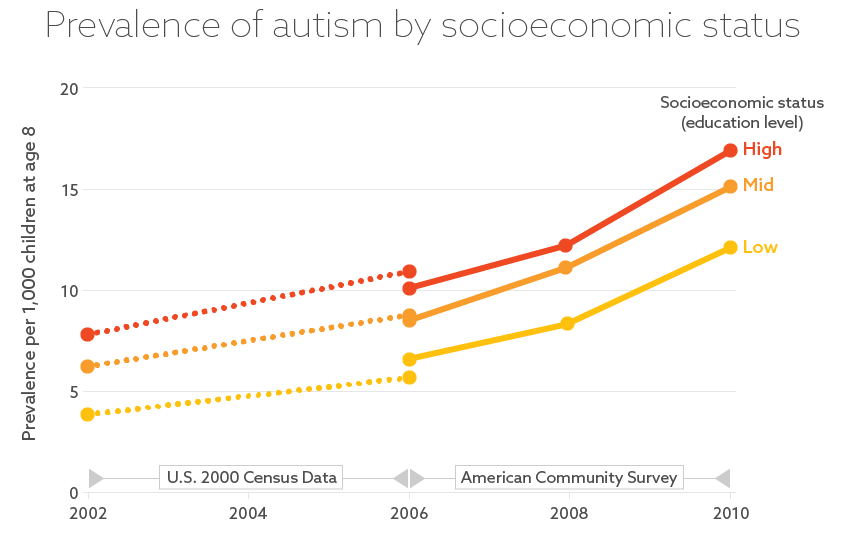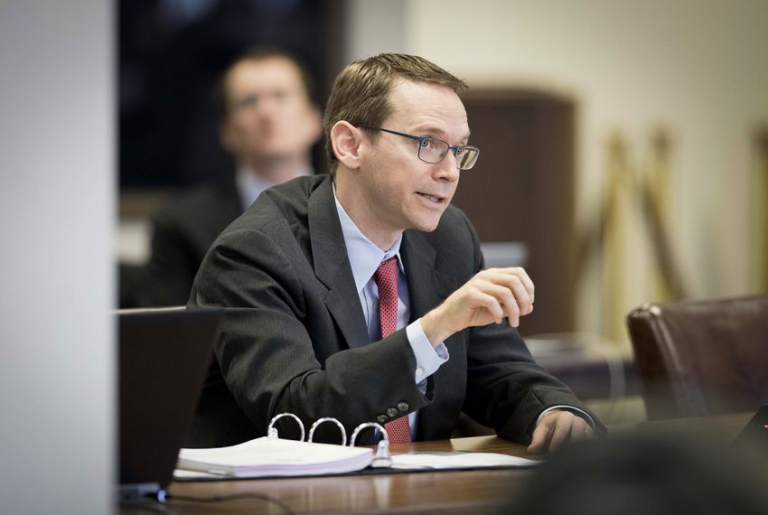The U.S. Department of Education is laying the groundwork for a reauthorization of the nation’s primary special education law.
The agency said it plans to conduct several surveys this fall to gain a better understanding of how the Individuals with Disabilities Education Act is being implemented across the country.
Information gathered will be used by the Education Department, Congress and other stakeholders to plan for the law’s next update, according to a Department of Education notice published this month in the Federal Register.
“This study of IDEA is necessary because a decade has passed since the previous IDEA national implementation study, and subsequent developments may have influenced the context and implementation of special education and early intervention,” the notice indicates.
For the study, the Education Department plans to survey every state-level entity that receives funding under IDEA as well as a nationally-representative sample of schools and school districts.
The data collection dubbed the Individuals with Disabilities Education Act (IDEA) State and Local Implementation Study 2019 is one piece of the National Assessment of IDEA, which is mandated by Congress, the Education Department said.
The IDEA was last reauthorized in 2004.
An investigation by the Houston Chronicle has revealed that unelected state officials in Texas “arbitrarily decided what percentage of students should get special education services” more than a decade ago and then began auditing school districts that did not comply.
Their efforts, which started in 2004 but have never been publicly announced or explained, have saved the Texas Education Agency billions of dollars but denied vital supports to children with autism, attention deficit hyperactivity disorder, dyslexia, epilepsy, mental illnesses, speech impediments, traumatic brain injuries, even blindness and deafness, a Houston Chronicle investigation has found.
The newspaper’s reporter, Brian Rosenthal, found that state officials set a cap of 8.5 percent of students who should receive special-education services, far lower than the national average. According to the U.S. National Center for Education Statistics, the overall percentage of those being served in programs for students with disabilities was 12.9 percent in 2012-13, the most recent year for which statistics are available, down 13.8 percent in 2004-05. In 2015, the 8.5 percent was reached for the first time, dropping from 12 percent a dozen years ago, the newspaper reported.
According to Educational Psychologist and Special Needs Advocate, Dr. Ifeanyi Ufondu, “Texas is the only state that has limited the percentage of students to whom it will provide special-education services in this manner. This is totally unacceptable.”
If Texas provided services at the same rate as the rest of the U.S., 250,000 more kids would be getting critical services such as therapy, counseling and one-on-one tutoring.
– Dr. Ifeanyi Ufondu, Beautiful Minds Inc. – Advocacy & Special Needs Solutions
In its response to the Chronicle, the Texas Education Agency denied that it had set 8.5 percent as a mandated goal and instead described it as an “indicator.” It also said that it did not punish districts that did not comply. Still, Texas Education Commissioner Mike Morath said his agency would conduct a detailed review of the special-education program in the state, and House Speaker Joe Straus (R) said he would work with the agency to address this issue.

The newspaper reported that districts that provided more than 8.5 percent of students with special-education services were asked to file “corrective action” plans for how they were going to lower their special-education populations.
The Chronicle also found that TEA officials arbitrarily established the 8.5 percent standard in the face of a $1 billion budget cut without the benefit of any research on its impact or on how deeply to reduce special education. The national average for students receiving special education is about 13 percent.
Ironically, the 8.5 percent cap was set in 2004, the same year that Congress updated the 1975 Individuals with Disabilities Education Act, which was passed to ensure that all children with disabilities have the opportunity to receive a free and appropriate public education.
Texas, however, is hardly the only state that has mismanaged its special-education program.
For example, the Connecticut State Department of Education said last month that the two largest school districts in the state — Hartford and Bridgeport — were not meeting federal and state laws in regard to providing students with disabilities an appropriate education, according to the CT Monitor.

The Iowa Department of Education recently cited more than 100 incidents of noncompliance with federal laws and regulations in the Iowa City school district’s special-education program, according to the Gazette.
Michigan Radio just published a story saying that special-education funding in the state is so complicated that nobody can say categorically how much it costs to educate a special-education student:
Figuring out all the different pots of money that go into paying for special education is complicated, but you know what’s even more complicated? Figuring out how much special education in Michigan actually costs. And if we don’t know that, we don’t know whether we’re spending too much or too little on special ed.
It’s so complicated even the people who specialize in school finance can’t figure it out.
Forty-one years after IDEA was first passed, special-education programs nationwide remain in serious need of proper funding and reform. This is from a 2015 post on the Rethink blog, an evidence-based platform for special educators:
Yet despite the integral role the law has played in granting students with special needs access to education and inclusion opportunities, it remains flawed and underfunded. Red tape and complicated financial provisions continue to make it difficult for school districts to efficiently and effectively serve students with disabilities while complying with the law’s rules and regulations. Furthermore, in part due to some of these problems, special education teachers are leaving the profession in droves, making qualified teachers harder and harder to come by….
The challenges special education teachers face are enormous, and addressing these challenges can be equally as daunting. But if IDEA is to accomplish what it set out to accomplish 40 years ago–to ensure that all students have access to a free and appropriate public education–having high quality teachers to teach our special education students is a non-negotiable. Reauthorization of IDEA is now 6 years overdue. As policymakers rethink the law’s provisions, considering how IDEA is impacting teacher satisfaction and teacher quality should be a top concern. For now, districts must look at creative ways to address these challenges with the tools and resources available at their disposal.
The findings highlight persistent racial disparities in autism prevalence: White children are about 19 percent more likely than black children and 65 percent more likely than Hispanic children to be diagnosed with autism.
Autism prevalence in the U.S. has more than doubled since 2002. Researchers have looked to changes in the condition’s diagnostic definition and greater awareness among parents as possible explanations for this rise.
They have also assumed that access to good schools and medical care would explain much of why white children and those of high socioeconomic status are more likely than black and Hispanic children and those of low socioeconomic status to be diagnosed with autism.
The new study upended many of these assumptions.
The findings suggest that socioeconomic status doesn’t fully explain the differences in prevalence across race and ethnicity.
“Everything is a little bit more complicated than we thought,” says Maureen Durkin, lead researcher and professor and interim chair of population health sciences at the University of Wisconsin-Madison. “We’ve been trying to understand the racial and ethnic difference in prevalence, and it isn’t so simple as that it’s explained by social class.”
Prevalence climbs:
Durkin and her colleagues analyzed surveillance data from the U.S. Census Bureau and the U.S. Centers for Disease Control and Prevention’s (CDC) Autism and Developmental Disabilities Monitoring Network. The CDC database includes health and education records for more than 1.3 million children at age 8. Of those, the clinicians identified 13,396 children who either had an autism diagnosis or would meet the criteria for a diagnosis.
The team used census data on the proportion of adults with college degrees in a neighborhood as a proxy for socioeconomic status. They stratified the results by race and ethnicity to determine whether socioeconomic status alters their findings on prevalence.

Graph by Nigel Hawtin
Autism prevalence rose almost evenly among high-, middle- and low-socioeconomic groups between 2002 and 2010, the researchers found. The rates increased from 3.9 to 9.3 per 1,000 children in the low-socioeconomic group, from 6.2 to 11.6 in the middle class and from 7.9 to 13.4 in the high-socioeconomic group.
This was a surprise. The research team had expected that prevalence in the high-socioeconomic group in 2002 was “the true prevalence” and that the numbers for that class would stabilize over time, Durkin says. “But it really didn’t.”
Across the classes, prevalence roughly doubled in the three racial and ethnic groups: It rose from 6.7 per 1,000 children to 13.2 among white children, from 5.9 to 11.1 among black children and from 3.9 to 8 among Hispanic children.
This suggests that autism awareness and access to services are increasing across racial and ethnic groups, but the prevalence among minority children still lags behind that of white children.
Persistent gaps:
When the researchers looked more closely within each racial and ethnic group, they found that differences in prevalence across socioeconomic classes either stayed the same or became smaller.
For instance, the difference in prevalence between low- and high-income white children decreased over the study period. This suggests low-income white families are becoming more aware about autism over time, Durkin says.
Among blacks and Hispanics, however, the gap between low- and high-socioeconomic classes remained level.
Surprisingly, the rate of autism among black children in the high socioeconomic group was higher than that among white or Hispanic children between 2002 and 2010.
“It’s intriguing that in higher-social-class blacks, there’s no shortage of autism,” Durkin says. “Black children are much more likely to be in the low-socioeconomic group than white children,” she says. The finding supports the idea that lack of access to diagnostic services contributes to the overall lower prevalence of autism in black children.
There is no biological reason for autism prevalence to differ across racial and ethnic groups. The disparities are simply astounding, says Dr. Ifeanyi Ufondu, Howard University alumni, Educational Psychologist and founder of Beautiful Minds Inc.- Advocacy & Special Needs Solutions, who was not involved in the research.
“The fact that we continue to see this in all of our prevalence studies in the U.S. suggests to me that we really just don’t know what the true prevalence of this condition is, particularly among kids of color, primarily African-American and Latino children,” he says.
Parents in some groups may be less concerned or aware about autism, and may not seek out a diagnosis for their child, says Craig Newschaffer, director of the A.J. Drexel Autism Institute in Philadelphia. Newschaffer was not involved in the study but wrote a commentary about the work in the same issue of the journal2.
Another study published this month suggests black parents report fewer concerns about social problems, repetitive behaviors and other autism features than white parents do3. Language barriers may contribute to the lower prevalence among Hispanic children. A study from October showed that a child’s race or ethnicity isn’t related to the time between diagnosis and treatment4.
Parental age may also contribute to the disparities. Advanced paternal age is associated with an increase in autism risk, and fathers of white children tend to be older than those of black or Hispanic children.
The twelfth annual World Autism Awareness Day is April 2, 2019.
Joined by the international community, hundreds of thousands of landmarks, buildings, homes and communities around the world, light blue in recognition of people living with autism. Autism-friendly events and educational activities take place all month to increase understanding and acceptance and foster worldwide support.
Join us for World Autism Month!
Also view
Written by Daniel Ngwere. April 1, 2019
Ermias Davidson Asghedom, better known professionally as beloved Los Angeles rapper Nipsey Hussle, has died after being shot 6 times in front his Marathon clothing store in LA. He was 33. He is survived by two children, Emani and Kross and his wife, Lauren London. His death was confirmed by NBC News, who reports that he died from injuries sustained from gunshot wounds. TMZ also confirmed.

(Last known photo of Nipsey Hussle alive..., taken moments before his death pictured here with two year old son, Kross)
Nipsey, affectionately referred to in the Crenshaw district of LA where his store is located as Neighborhood Nip, was a fixture of the community, growing up in the area and eventually founding his clothing store there, and buying the remaining storefronts in the plaza surrounding it, which faces the corner of Slauson Avenue and Crenshaw Boulevard. Both streets figured prominently into his music, as does his upbringing as part of the Rollin 60s Neighborhood Crips gang that patrols the area.

Nipsey had big plans in the works; a full length documentary on the 1985 Trial of Dr. Sebi, a holistic herbalist who claimed to have cured HIV/AIDS, Cancer, Diabetes, paralysis, and other medical issues and was sued by the U.S government and won not only one case, but two federal cases. Nipsey’s most proud venture was “Too Big To Fail” a Science, Technology, Engineering and Math(STEM) center and maker space for youth in Los Angeles’ Crenshaw neighborhood.
The rapper planned to launch the academy with his business partner and real estate developer Dave Gross. The 33-year-old said that he hopes the space can be a “bridge between Silicon Valley and the inner city.” Nipsey and Gross planned on partnering with his cousin, Los Angeles native and lifelong educator, Dr. Ifeanyi “Allah” Ufondu, Educational Psychologist and owner of Beautiful Minds Inc.- Advocacy & Special Needs Solutions. Ufondu, also a product of the South Central neighborhood Nipsey grew up in, was scheduled to collaborate with Nipsey and Gross to create a multi-cultural, critical thinking curriculum aimed at developing global thinkers out of local, inner-city, At-Risk youth.
This is a great loss, not only for Lauren, Emani and Kross, but for the city of Los Angeles and the world! Hip-Hop lost an amazing talent who poured his mind, money and spirit into the neighborhood that bore him! A champion for redemption, family, entrepreneurship, youth education and holistic health. This was not one of US that took Nipsey from US…This was something much deeper! When a man makes it from here (S. Central Los Angeles, CA) on his own merit, his own terms, without taking any oaths or sacrificing his soul…Owning his own masters, buying back his neighborhood residentially and commercially, creating schools and businesses for his own community, developing documentaries that would potentially expose the huge lies our government and pharmaceutical corporations feed us, and consistently spreading knowledge and gems to the unenlightened… He had to know that THEY were coming for him. REST EASY, YOUNG KING…REST EASY!
Dr. Ifeanyi Ufondu, Owner Beautiful Minds Inc.- Advocacy & Special Needs Solutions
The Los Angeles native didn’t plan to stop in California, saying that the first school would be “a model that we’re going to scale.” The duo had plans for STEM academies in other cities, such as: Atlanta, D.C., and Baltimore.
The ultimate goal is to create “a resource network across the country” that students can tap into for knowledge-sharing and networking.
To find out more about the initiative and how you can help, visit Too Big To Fail’s website.

Nipsey was fresh off the successful run of his first major label album, Victory Lap, which capped a decade of independent releases from the hometown hero, including a pair of mixtapes, Crenshaw and Mailbox Money, that he infamously sold for $100 and $1,000, respectively. Victory Lap was released in partnership with Atlantic Records and earned, among other things, a nomination for the 2019 Best Rap Album Grammy.
Beautiful Minds Inc. sends thoughts and prayers to the family and friends of Nipsey Hussle.
Joanne Tunchez’s 15-year-old son forgot to take his ADHD medication one Friday morning in late March. By the end of the day, he had been removed from his South Texas school and arrested for allegedly making a bomb threat in his culinary class.
When his teacher asked him to take off his backpack that morning, he told her, “It’s not like it’s going to blow up,” according to Tunchez’s later conversations with students who witnessed the incident. Tunchez said the school failed to thoroughly investigate the matter before removing him, violating federally mandated procedures for removing a student with a disability.
As a recent spate of school shootings has provoked nationwide panic, some advocates and parents, like Tunchez, are worried school and state officials’ response to the May massacre at Santa Fe High School could harm some students more than it protects them.
Criminal charges have since been dropped for Tunchez’s son, who has ADHD and anxiety, but he missed more than two weeks of school, spent a couple of days in juvenile detention and failed the state standardized English test required for him to graduate.
“I understand they were not going to tolerate kids making a terroristic threat. But they assumed it was a terroristic threat, when it was not a threat at all,” Tunchez said. “Because they didn’t listen to what we were trying to say, he still has to suffer a consequence for something he didn’t do.”
The state government’s response to the heightened fear of school shootings has stemmed from a 40-point list of school safety recommendations released May 30 by Gov. Greg Abbott, compiled after three days of roundtable discussions with teachers, law enforcement, mass shooting survivors and advocates on both sides of the debate over guns.
Those recommendations have added fuel to a longstanding debate over how schools should balance classroom safety with the rights of vulnerable students.
Advocates for less-punitive disciplinary policies argue the governor’s plan is too focused on “zero-tolerance” discipline and would increase the likelihood that students of color and students with disabilities are kicked out of school and shuttled into the justice system. They fear education policy will swing back toward punitive discipline as educators and lawmakers grasp for immediate solutions to head off violence next school year.
“The Legislature has worked to undo some of the harmful discipline policies in current practice. The huge fear is what we’re seeing is a strong push to go backward … and going backward would harm very specific groups of people, primarily At-Risk and children of color. Our job as educators, parents, and Special Needs advocates is to ” said Dr. Ifeanyi Ufondu, Educational Psychologist and founder of Dallas based Beautiful Minds Inc. – Advocacy & Special Needs Solutions a national, full-service advocacy firm that represents At-Risk and Special Needs students and families.

Disproportionate punishment
Following a national trend, Texas students with disabilities, as well as, Black and Hispanic students are already disproportionately suspended or expelled for misconduct, often removed from school and placed in disciplinary alternative education programs where they are temporarily educated separately from their peers. Past state audits of these programs have shown their limited success in educating kids, increasing the students’ likelihood of dropping out once or before they return to their regular campuses.
Abbott’s plan includes recommendations to make it easier for teachers to remove students they suspect of violence from their classrooms by adding stalking, cruelty to animals and possession of weapons on school property to the list of offenses that could trigger removal. It also recommends creating systems to address the root causes of students’ misbehavior, including any mental health needs, once they are removed from classrooms.
“What’s really concerning is having the state expand any sort of offenses and put a stamp of approval on using [disciplinary programs] as a response to student behavior,” said Morgan Craven, a staff attorney at nonprofit advocacy group Texas Appleseed. She agreed students who misbehave should receive extra counseling and support — but well before they are suspended or expelled. “Zero tolerance doesn’t ask any questions or get to what the issues are. It just says, ‘We’re going to push you away,’” she said.
Abbott’s plan also indicates that school districts should follow existing specialized behavior management plans for students in special education who act out because of their disabilities, instead of moving to suspend or expel them, through protections laid out in federal law.
Despite the existing federal protections, students with disabilities are overrepresented in disciplinary alternative education programs. In 2016, they made up 16 percent of the programs but just 8.8 percent of the student population.
Already, education lawyers are noting more cases where students are removed from school for allegedly making terroristic threats, one of a long list of behaviors that can trigger placement in a disciplinary program.
“We’ve seen that students with behavioral and emotional disorders, who have disabilities in those areas, have been the target of those disciplinary removals,” said Hank Bostwick, a lawyer at Texas RioGrande Legal Aid who manages special education cases. “When the child has a disability, that substantially impairs the student’s capacity to appreciate the wrongfulness of his or her actions.”
Teachers divided
Classroom teachers are more divided on the issue of punitive student discipline, with some arguing that they need more tools to be able to ensure students who put them and other students at risk are not simply left without consequences or help.
“We don’t want students being unnecessarily removed from classrooms. … On the other hand, we don’t want teachers’ hands so tied that they can’t exercise an option allowed in the law to address persistent misbehavior,” said Paige Williams, staff attorney and director of legislation for the Texas Classroom Teachers Association.
In 1995, in response to a federal mandate, Texas passed the Safe Schools Act, which required all school districts to provide separate educational settings for students who are suspended or otherwise removed from regular classrooms due to bad behavior. A couple of decades later, with educators leaning on classroom removals and the criminal justice system to deal with classroom management, lawmakers passed a series of laws rolling back zero-tolerance discipline policies and requiring school leaders to consider alternatives to expelling or suspending students.
Four years ago, the Legislature banned out-of-school suspensions for students younger than third grade.
With the turn in policy, many teachers are concerned that they are losing their authority over classroom management and that administrators are not taking seriously their concerns over daily acts of student violence, Williams said. “We were hearing a lot of complaints from teachers who were sending students for behavior issues to the principal and there being no consequences once they got to an administrator,” she said. Teachers responding to an informal TCTA survey said lack of administrative support in student discipline issues was a key factor in their decisions to leave the profession, a data point cited in Abbott’s plan.
Williams said she has heard from many teachers who were scared for their own safety due to students making perceived terroristic threats, but who had not been taken seriously by administrators or law enforcement.
“We need a holistic approach,” she said. “It’s hard for me as a representative of teachers to say when someone threatens them that they shouldn’t take it seriously and shouldn’t do what they need to do to feel safe in their classrooms.”
State efforts so far
State Sen. John Whitmire, a Houston Democrat, authored a 2015 law that in part requires districts to establish “campus behavior coordinators,” who could be the principal or another school administrator, to determine how best to discipline a student sent to the principal’s office — which would help ensure teachers’ concerns were taken seriously and that students were treated fairly.
But more than 150 school districts have exempted themselves from that requirement through a separate 2015 law intended to give districts more flexibility in following state regulations, according to a TCTA count this spring.
Dr. Ifeanyi Ufondu, who is a current candidate for the Mansfield Independent School District Board of Trustees Place 3 want to change the blockage parents and students face and create a more transparent school board that affords parents greater access to how these issues are dealt with. “Some of those school districts have instead installed their own behavior and discipline management plans, Ufondu told The Texas Tribune this week. “Prior to some new changes in 2015, everyone was saying there was no consensus who was in charge,” he said. “Parents don’t know who to talk to. Teachers don’t know who was looking out for school discipline.”

Police officers placed on campus ended up handling school discipline, giving out tickets to students for minor infractions. Ufondu said he is concerned the current focus on school safety might prompt a reliance on law enforcement, which could further the fast-tracking of At-Risk, Black and Latino students to the Prison Pipeline.
“Now we’re in a period where everyone’s afraid,” he said. “We all have the same goal: school safety. But you’ve got to be very cautious that you don’t create some unintended, and at times, intentional consequences.”
In fact, one of Abbott’s proposals was to station more police officers in schools, and districts are already moving forward with such plans. But Rose echoed Whitmire’s concerns, saying it would increase the likelihood that teachers and administrators rely on the criminal justice system to deal with behavioral issues.
Black and Hispanic students are more likely to be arrested, ticketed and referred to juvenile probation than white students, though they are not more likely to misbehave, according to a 2016 report from Texans Care for Children and Texas Appleseed. “Creating new opportunities to remove students from the classroom is creating more opportunity to socially isolate them and putting students on a path away from success,” Rose said.
At a state-sponsored roundtable in late May, family members and survivors of recent school shootings pitched Abbott ideas for what would make them feel more safe in their schools, such as stationing more police officers, making it easier to arm teachers and having students report any suspicious behavior.

Many details of Abbott’s plan mirrored the proposals from that conversation, half of which was open to the media.
Advocates argue any plans to make schools safer should consider the experiences of a broader group of students.
“It’s really important to get input from students who have been through these horrible shootings,” Rose said. “To craft policies that create safe and supportive schools, it’s also important to get the perspective of students who have experienced the inappropriate, unintended consequences of zero-tolerance policies and having police in our schools, like students with disabilities and students of color.”
Disclosure: Beautiful Minds inc.- Advocacy & Special Needs Solutions, The Texas Classroom Teachers Association and Texas Appleseed have been financial supporters of The Texas Tribune, a nonprofit, nonpartisan news organization that is funded in part by donations from members, foundations and corporate sponsors. Financial supporters play no role in the Tribune’s journalism. Find a complete list of them here.
Preparing to ask the federal government for $1 billion in special education grants, Texas education officials have indicated they do not expect to be able to adequately educate kids with disabilities until June 2020.
Texas is in the middle of a federally mandated overhaul of special education after a federal investigation found the state had for years been effectively denying students with disabilities the tools and services they needed in order to learn. Last May, state education officials submitted an application for federal funding saying they would comply with all federal requirements by this January, a timeline that appears to have been extended by a year and a half.
State education officials say they have completed their special education overhaul and are waiting for the federal government to clear them.
“TEA has met all its commitments made in the corrective action plan and has initiated a five-year strategic plan to not only meet compliance with federal requirements, but to significantly improve the standard of service to students with disabilities across Texas,” said spokesperson DeEtta Culbertson late Wednesday.

Before the state formally applies for an annual special education grant from the U.S. Department of Education, it must post the application on its website for two months and allow the public to comment.
The TEA indicated in the application that it could not ensure all students with disabilities get an adequate public education, that students are properly identified for needed special education services or that school districts are being monitored — until June 30, 2020.
That has angered disability rights advocates, who used what should have been a perfunctory public hearing Wednesday afternoon to air their grievances against the state for its repeated failure to overhaul special education.
Educators “cannot say that we’ll delay for another 18 months providing” free, appropriate public education, Kristin McGuire, who represents the Texas Council of Administrators of Special Education, told a panel of TEA special education employees. “I implore the agency to set out guidance as quickly as possible and to partner with districts … to make sure we’re providing what we need to for our kids.”
News of the delay comes not long after a commission tasked with reforming the state’s school finance system failed to include recommendations to help students with disabilities. Instead, the commission — which included several lawmakers — decided to wait until state education officials could fully implement promised changes to its special education program.
In 2017, lawmakers forbade the TEA from capping the percentage of students receiving special education at 8.5 percent. That percentage has since risen to 9.1 percent — thousands more students.
The federal government has repeatedly reprimanded Texas for violating special education law, most recently last year for decreasing spending for kids with disabilities — which a New Orleans federal appeals court ruled was in violation of federal statute. That ruling will cost Texas $33 million in federal grant money, about 3 percent of its total annual special education grant.
A federal judge wrote in the unanimous opinion that Texas’ system for funding special education “creates a perverse incentive for a state to escape its financial obligations merely by minimizing the special education needs of it students.”
Advocates also expressed concern Wednesday that the TEA’s recent grant application did not address this loss of funding.
TEA officials have said they’re building infrastructure to hold school districts accountable for not providing students with disabilities with the appropriate tools or classes they need in order to learn, and to find the thousands of students who have been left out of those services in the past. They changed the structure of their departments overseeing special education, hired a special education director last August after the position had been empty for nine months and are in the process of soliciting applications for more than $20 million in grants to help school districts overhaul their programsS
More than 750,000 adults behind bars report having a disability, with two-thirds experiencing a cognitive disability. A recent white paper by the non-profit group RespectAbility advocates criminal justice reform that specifically addresses the needs of people with disabilities. Stories within the report give human faces to the numbers; people featured include those with learning disabilities. The group calls for reforms that will provide pathways to success:
- Early interventions to keep youth with disabilities from entering the school-to-prison pipeline;
- Adequate accommodations throughout the criminal justice system; and
- A re-entry process that understands the unique challenges facing citizens returning to the community with varying kinds of disabilities.
Disproportionate impact
Incarceration in the U.S. disproportionately impacts people of color and people with disabilities. The report highlights the need for criminal justice reform, citing startling incarceration statistics:
- The U.S. is home to 5 percent of the world’s population but 25% of the world’s prison population.
- More than 60 percent of the people in prison are now racial and ethnic minorities.
- While the U.S. Census reports that one in 5 Americans (20 percent) have a disability, the Bureau of Justice found that 32 percent of federal prisoners and 40 percent of jail inmates report at least one disability.
The report points up the fact that people with disabilities are twice as likely to be victims of crime than people without disabilities. A third to a half of all use-of-force incidents with police involve a disabled civilian.
Prevalence of disabilities
More than two-thirds of the 750,000 incarcerated individuals who reported having a disability reported a cognitive disability, the largest of the six disability groups. This represents 20 percent of state and federal prisoners and 31 percent of jail inmates.
Because there is no universally accepted definition of disability, inmates surveyed by the Bureau of Justice in 2011-2012 were asked to respond to six questions addressing their hearing, vision, cognitive, ambulatory, self-care, and independent living abilities. Regarding cognitive ability, researchers asked, “Because of a physical, mental, or emotional problem, do you have serious difficulty concentrating, remembering, or making decisions?”
In public interviews and/or the report itself, two of the report’s co-authors have self-disclosed their own dyslexia. The report does not cite figures on the prevalence of learning disabilities among incarcerated adults, but it references a 2005 national survey that found 36 percent of students in the juvenile justice system had learning disabilities. Calling for better assessments and better data to generate good policy, the report’s authors lament, “The lack of data on the rates of people with learning disabilities in the justice system is particularly a problem as there is no recent quality data looking nationally at prevalence rates in the justice system” (p. 26).
Anchoring statistics in human experience
The intersection of risk factors—including disability, racism, and poverty– coalesced in the death of Freddie Gray. Raised in an economically disadvantaged neighborhood and a home surrounded by lead paint, Gray had a developmental disability that may have compromised executive function and his ability to follow multi-step instructions. He did not receive an early diagnosis with interventions and appropriate supports; following suspensions, he dropped out of school and into the justice system– with tragic consequences.
New Orleans-born actor and activist Ameer Baraka struggled in school, was labeled “stupid” and “dumb,” and felt “hopeless and lost.” He avoided spelling tests, hiding in school hallways to avoid embarrassment and turning to street gangs for excitement and support. Incarcerated as a youth and adult, Baraka, at age 23, was reading at a third-grade level when he was finally diagnosed with dyslexia while in prison. With appropriate supports, he earned his GED within four years and began teaching others the skills he learned. Since his release, Baraka has produced four independent films, written an autobiography (The Life I Chose), and co-starred in the Fox hit, American Horror Story and HBO’s Treme. Oprah Winfrey featured him on her “Blackboard Wars” program for his dedication to mentoring at-risk youth, and he recently testified before a U.S. Senate Education Committee hearing on dyslexia.
Recommendations to scaffold success
The report’s authors offer 18 policy recommendations to scaffold success for individuals with disabilities at each stage of the criminal justice system. Calling attention to the report’s extensive collection of data, tables, facts and figures, they advocate use of a disability lens in the conversation about reform:
“Proposed criminal justice reforms have begun to address the disparate impact that our broken justice system has on racial and ethnic minorities. However, those same reforms need to consider the intersection and impact of disabilities.”
Reference:
Mizrahi, J. L., Jeffers, J., Ellis, E. B., & Pauli, P. (2016). Disability and Criminal Justice Reform: Keys to Success. Published by RespectAbility USA. Available at http://respectabilityusa.com/3851-2/
By: Natalie Hopkinson
Repost: February 4, 2014
A black Brooklyn couple sit in their car waiting to hear what New York City’s elite Dalton School has to say about their son now. The dad wonders: “The question is, what is it about Idris that makes him disruptive?”
They take turns reading the school’s latest communiqué: “Talks out of turn continuously … impulse control. Has trouble respecting other students’ physical boundaries. [Needs to] focus on not distracting others.”

As we learn in the couple’s documentary film American Promise, which aired Monday on PBS and is available for streaming online starting today, the school suggested that the boy might have attention deficit/hyperactivity disorder. When Idris was 4, the couple had him independently evaluated. They accepted the diagnosis but resisted prescription-drug treatment—at first. Later in the film, which follows their son and his best friend from kindergarten though high school graduation, Idris pleads with his parents to reconsider. His grades were mediocre. It might help, he reasoned.
When I saw this scene, my heart dropped—nearly as much as it did when young Idris said that he would be better off at his school if he were white.
I will admit to being one of those slightly paranoid black people who suspect that big pharma is trying to put us back in chains. But researchers have similar fears for a generation of kids of all races. In the recent New York Times investigation “The Selling of Attention Deficit Disorder,” prominent researchers called the marketing-driven explosion in diagnoses (600,000 in 1990 to 3.5 million today) a “national disaster of dangerous proportions.”
Black children are still diagnosed and medicated less frequently than white children, but they are catching up fast. Between 2001 and 2010, there was a 70 percent increase in diagnoses among black boys and girls ages 5 to 11, according to a Kaiser Permanente study released last year.
The increase in the number of diagnoses is positive in the sense that the stigma around having this and other neurological and mental disorders is melting away, and children are getting the help they need. But I fear that slick marketing (Maroon 5’s Adam Levine is the face of one ADHD campaign) and the academic pressure cooker is turning ADHD meds into performance-enhancing drugs for the classroom.
Some doctors admit to prescribing Adderall and other ADHD drugs to low-income kids, not because they have a disorder but just to help them do better in school. “We might not know the long-term effects, but we do know the short-term costs of school failure, which are real,” a pediatrician told the New York Times.
In some ways the disorder is becoming another way to keep up with the Joneses. In upper-middle-class communities, parents trade intelligence on compliant psychiatrists right along with good tutors. A white friend once advised me to get the diagnosis before my son reached seventh grade.
“After that it doesn’t count,” she said, meaning that you can’t qualify for extra time on the SAT. After high school, the medications are highly coveted on college campuses for students wanting to pull all-nighters.
In my buppie parenting circles, we all seem to get the same not-so-subtle hints from school administrators about the deficiencies of our beautiful black sons. Is there something neurologically wrong with all of our boys? Or is something else in the culture at work? As one of the white Dalton administrators said, “There is a cultural disconnect between independent schools and African-American boys. The question is why.”
There are well-documented theories. Female-dominated classroom cultures punish boys. Toxic perceptions of black males in this country pollute the way schools interpret our boys’ behavior. There is pressure on teachers to maintain order in the classroom and produce results.
The ADHD drugs make boys more focused and compliant. But these medications can also potentially set them up for a lifetime of dependency and other side effects. Dr. Ifeanyi Ufondu, Educational Psychologist and founder of Beautiful minds Inc.- Advocacy & Special Needs Solutions, whom is also a veteran public school teacher and administrator in Los Angeles, CA, thinks that teachers and parents sometimes use the diagnosis as a crutch. “Sometimes it’s just poor teaching and not being in touch, culturally and socio-economically,” he said.
As the first male teacher at one high-poverty school, Ufondu worried about the prevalence of disciplinary referrals and the diagnosis in his male students. The boys were lethargic and complained of headaches and dry mouth. “Our boys appeared as zombies in the classroom,” he said. “They were constantly asking for water. You knew why they were behaving this way, but they were clueless,” Ufondu said.
But when the boys behaved poorly, parents were summoned to school. Single mothers especially couldn’t afford to constantly leave work, so the medication seemed like a godsend. But Ufondu convinced a group of parents to let him work with a group of second-grade boys on alternatives to medication. He created a structured system of routines with plenty of activities, short physical breaks and verbal prompts.
He knew some of the boys needed the medication to function normally. But over two years, for a majority of the group, Ufondu discovered dramatic improvement in both their behaviors and academic performance—with no medication. “They can avert the medication route,” Ufondu said. “They need to perfect the routine so they can get out their aggression in a healthy way. They need that release time to focus.”
The Brewster-Stephenson family came to a similar conclusion. Their son Idris used the medication for six months, and his academic performance soared, Brewster said in an interview with The Root. But Idris did not like the way the medication made him feel. So his parents took him off the prescription and used nonmedicinal interventions, including tutoring, rigidly scheduling his time and plenty of physical activity.
As a psychiatrist, Brewster is well aware of the resistance that black parents often have toward medicating their children and the highly subjective nature of how the disorder is diagnosed. “It is a highly personal and individual decision that families have to make,” he said.
If his son were at a public school, Brewster said, he probably would not feel the need to use medication. But they made the decision to put their son in the unforgiving academic environment and felt that they had to do whatever it took to help him succeed. They were very demanding of their firstborn son but made different choices for their younger son, who attends a more laid-back private school. “We also give him a lot more hugs,” Brewster said.
We all want our children to have the very best. We just have to decide if “success” on these terms is worth the price.
Natalie Hopkinson is a Washington, D.C.-based author whose current projects deal with the arts, gender and public life. She is the author of Go-Go Live: The Musical Life and Death of a Chocolate City. Follow her on Twitter.
By Daphne Charles
In May 2019, Mansfield Independent School District in Mansfield, TX will be electing several new school board members. Running for Place 3 is Dr. Ifeanyi Ufondu vs. Randall Canedy. As a lifelong educator from Los Angeles, CA, Dr. Ufondu wants to bring a fresh and innovative perspective to the board and looks forward to building with community and the district. I posed the question to Dr. Ufondu, “What would you say is the most important issue you would like to tackle in the district and sum it up in a few words?” His response was this…
For our students and district staff, we must harness their strengths and challenge their weaknesses. We as board members, mentors, family and educators must align together and discover their brilliance, on the meandering road to their hopes and dreams. In order to do so, STRONG LEADERSHIP is a must!
– Dr. Ifeanyi Ufondu
The United Educators Association of Texas mailed each candidate a platform questionnaire and asked that they answer candidly. Below is Dr. Ufondu’s questionnaire and he asks that you take the time to read and review and remember him at the polls for MISD BOARD OF TRUSTEES PLACE 3. How will you vote?
United Educators Association School Board Candidate Questionnaire
DR. IFEANYI UFONDU, MISD BOARD OF TRUSTEES PLACE 3 CANDIDATE

1. Please provide any personal background information you would like
to share with the employees of Mansfield ISD.
My name is Dr. Ifeanyi Ufondu aka “Dr. U” and I am running for Place 3 of the Mansfield ISD Board of Trustees. My wife Nicole and I, are Los Angeles, CA natives who relocated to Mansfield, TX in 2005 strictly by design. After discovering our eldest son Neiko had been diagnosed with ADD/ADHD, I researched the nation’s top school districts for kids with learning disabilities and discovered Mansfield ISD was cutting edge and ahead of its time… and the rest is history! I am an Educational Psychologist, lifelong Educator, Special Education Advocate and owner of Beautiful Minds Inc.- Advocacy & Special Needs Solutions. I hold a Baccalaureate and Master’s graduate in Educational Psychology from California State University, Long Beach and a Baccalaureate and Master’s graduate in Higher Education with an emphasis in Curriculum Development from Howard University. As a Ph.D. graduate at the University of London Kings College, my dissertation entitled “The Affect of Mitigating Race, Class and Gender on the Academic Success of the Young, Black Male: A Cross Cultural Ethnography” propelled my career into the arena of Special Education, and what better district to operate in than MISD?
As a former middle school English teacher and high school administrator in the Los Angeles Unified School District, which is the second largest district in the nation with over 600,000 students and over 1,000 schools and 200 independent charter schools, I excelled as a professional leader and mentor. I have also been a presenter of more than forty engagements, at national and international venues including Paris, the United Kingdom and Spain, and have been a guest on numerous radio programs. I have authored more than a dozen academic papers on hegemony, special education, minority education, globalization, and race, class, and gender in the U.S. public school system and abroad. I have served as a member of the International Honour Society at CSULB, Howard University, the Universite de Paris- Saint Denis, and the University of London’s King College.
2. What qualifications do you have that would make you an effective
trustee?
As a successful business owner of Beautiful Minds Inc. – Advocacy & Special Needs Solutions, a firm that represents “AT-RISK” students, parents, and economically disadvantaged communities in accessing the educational system and its resources in order to meet the academic and social needs of individuals with learning disabilities and behavioral disorders.
For the past seventeen years, I have employed over thirty-three employees, and handled a budget exceeding 5 million dollars annually. I am court-qualified as an expert in transition planning, vocational assessments, I.Q. assessments relevant to urban and At-Risk students in education, special education, and school evaluation, as well as other related areas. As the principal of Beautiful Minds Inc.- Advocacy & Special Needs Solutions, I am called upon by school administrators, attorneys and individuals from around the country to represent them. I also provide consultation to school administrators on issues such as special education, behavior management and over-representation of minorities in special education, as well as, to attorneys in cases involving schools and the education of children with learning and developmental disabilities.
3. Before running for the school board, how have you been involved in
the district?
First, as a parent of two children who have attended and graduated from Carol Holt Elementary, Cross Timbers Intermediate, T.A. Howard Middle School, Legacy and Summit H.S. respectively. My wife Nicole and I currently have our youngest son, Jackson, who is a Gifted & Talented student attending Carol Holt Elementary.
Secondly, as a former member of the Cross Timbers Intermediate PTA, where my role and duties where to actively participate in our students daily scholastic and extra-curricular activities on campus.
Finally, as an Educational Psychologist and Special Needs Advocate, I have represented both students and parents of children with developmental and behavioral disorders in cooperation with MISD ARD/IEP committees in order to attain special financial and scholastic accommodations for students and families in need.
4. As a board member, what would you see as the board’s role in
providing competitive salaries and benefits for its employees?
As a board member, I strongly assert that our role collectively is to ensure that district is transparent, responsive to the values, beliefs and priorities of our community, and that we assiduously seek competitive salaries and benefits in order to retain and sustain the talent we employ. I would like to research other successful, comparable districts and ascertain what they have done to provide competitive salary and benefits packages, while pushing our teachers and administrators to strive for greater academic and social success in their schools. As a former teacher and administrator, I know how exciting and rewarding it can be to provide an excellent education and mentorship to students, and most times at the expense of your own family and personal self. I know what it feels like to go above and beyond, professionally, mentally, physically, emotionally and financially for our students, and not feel appreciated by students, staff and parents. I know first hand, that teaching is the most over-worked and underpaid profession, and their responsibility is to shape the minds of our future, all while sacrificing their all… not for monetary profit, rather personal, selfless gain. It is our duty as board members to continuously to support our district employees and show gratitude for their significance.
5. What three issues do you think are the most important facing MISD?
Please explain.
Transparency: The number one issue facing the school board, most school boards, throughout the country is Transparency. As a MISD parent myself, I sense there is no pellucidity in how the board operates, what their goals are, how tax money is being spent within the district, what special committees get funded versus others, etc. As a former teacher, I would always question what side the district boards sat on, or if they actually fought for the concerns of those on the front line. I believe a special, informal monthly dialogue between, not only teachers, administrators, and board members, but also open the meeting up to other district employees such as maintenance, janitorial, athletic, and para-professionals and select student leaders to join in on the discussion.
Technology: In the growing age of technology and social media, as a board, it is our duty to stay ahead of the curve. As we rapidly continue to move away from using pencils and textbooks to Ipads and Smartboards, we must be financially and physically prepared to tackle the continuously changing technology our students and staff need to compete. We must be able to staff IT personnel who can install, monitor and repair said technology. We must not only listen to the needs of our staff, but also adhere to the advice of student leaders on what is technologically new and fresh. I also assert that the district should look into investing in a more advance Wi-Fi system that operates at a faster speed and greater reach with less buffering breaks in active time in order for our students to continue to be academically efficient.
Continued Growth: It is simple! The greater our district success the more our reputation grows. That means more families will want to come and relocate from throughout the state and beyond… just as Nicole and I did in 2005. With approximately 6,000 people moving to Mansfield every year, at least 1/3 will be students in MISD. We have to be prepared to handle the growth and it will be our proven leadership that determines how successful we remain.
6. Please discuss any other issue you feel is relevant to your campaign
for the MISD School Board.
As an Educational Psychologist and Special Needs Advocate, I would like to be the voice of the overlooked parent(s) of a Special Needs child(ren). I would like to shed a light on the unfortunate invisibility that some of our Special Needs students face and make available resources and support they may not know was previously and currently available to them and their families. I would like to be their hope and their difference on this board. Thank you.










